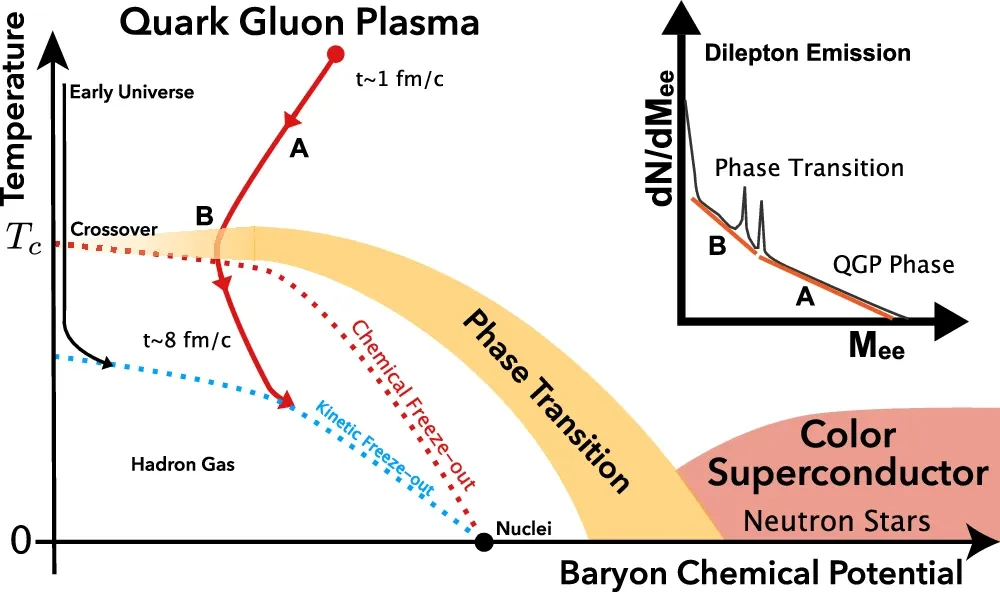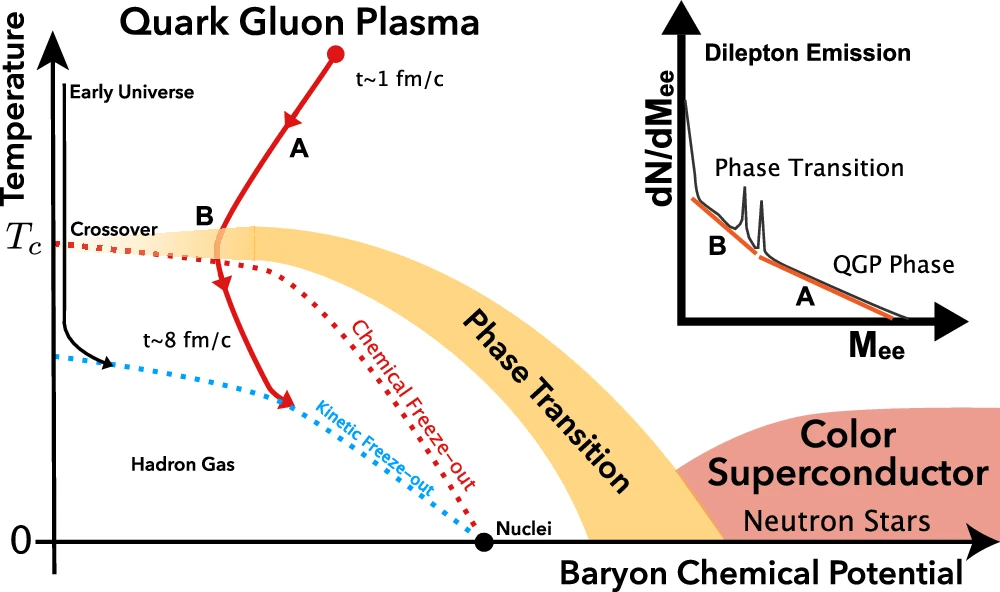UPTON, N.Y. βÄî October 14, 2025 βÄî An international team of researchers has directly measured the temperature of quark-gluon plasma (QGP) βÄî the superhot primordial matter that filled the universe just millionths of a second after the Big Bang. Among the leaders of this breakthrough is Χ«–ΡVlogΤΤΫβΑφ Professor Zhangbu Xu, a former spokesperson of the STAR experiment at the U.S. Department of EnergyβÄôs (DOE) Relativistic Heavy Ion Collider (RHIC).
The new study, by the STAR Collaboration, shows that QGP βÄî a short-lived state of matter created when gold ions collide at nearly the speed of light βÄî reached 3.3 trillion degrees Celsius in its earliest stage, then cooled to about half that as it transitioned into ordinary nuclear matter. For comparison, thatβÄôs more than 220,000 times hotter than the SunβÄôs core.
The results mark the first time RHIC has been able to directly extract QGP temperatures across different stages of its evolution. Past measurements using photons βÄî particles of light βÄî were complicated by distortions from the rapid expansion of the collision fireball. By contrast, the STAR team turned to dileptons, rare electronβÄ™positron pairs produced in the collisions. These pairs provide an addition quantity, βÄ€invariant massβÄù, that is invariant under relativistic Lorentz transformation and therefore remain unaffected by the Doppler-like shifts that plagued photon-based probes, making them an ideal thermometer for the primordial plasma.
Dileptons βÄî pairs of electrons and their antimatter partners, positrons or pairs of their cousin lepton family, muons βÄî have long been considered the βÄ€Holy GrailβÄù probe of quark-gluon plasma. Dileptons do not participate in the strong interaction with the QGP and can escape intact after creation. In a special invariant mass range, called low-mass range (LMR), the dileptons are mainly from the decays of a special particle called βÄ€rho0βÄù (“œ0). What makes this range special is that this “œ0 particle changes its properties with temperature and density and embeds the information in the decay to the pair of leptons. By observing the spectral function of this particle from dilepton measurement, we can understand where it comes from and at what temperature. At the intermediate mass range (IMR) just above LMR, the dileptons are mainly from QGP radiation when it is the hottest. Earlier experiments at EuropeβÄôs CERN laboratory and GermanyβÄôs GSI Helmholtz Centre for Heavy Ion Research used high-intensity ion beams striking stationary targets to study QGP under conditions where the created matter contained a high density of nucleons, or baryons, left behind from the projectile and target. Their measurements of temperature from dileptons with high statistics provide a benchmark for this type of probe.
What makes RHIC unique, researchers say, is its ability to accelerate and collide both beams of heavy ions at nearly the speed of light over a wide range of ion species and energy. This creates a form of baryon-free matter βÄî a state far closer to the conditions of the early universe immediately after the Big Bang. By scanning collisions across a wide range of energies, the STAR team could explore how QGP behaves under dramatically different conditions. That range proved essential. The measurements showed that, despite the differences in collision energy, the late-stage temperatures βÄî taken in the LMR just as the plasma began to cool and transition into ordinary matter βÄî are the same across the board. Even more striking, all those values aligned with the predicted phase transition line between quark-gluon plasma and ordinary nuclear matter.
βÄ€That was a surprise, and one we were thrilled to see,βÄù said Χ«–ΡVlogΤΤΫβΑφ physicist Zhangbu Xu, underscoring the importance of the finding. βÄ€It means we can almost pinpoint the exact temperature where the universe made that transition.βÄù
Χ«–ΡVlogΤΤΫβΑφβÄôs contribution highlights the universityβÄôs long-standing presence in high-energy nuclear physics and its role as a founding member of the STAR international collaboration in 1991. Xu, emphasized that decades of collaboration, data collection, and technological development went into achieving this milestone. The original STAR experimental design did not include a dilepton program in its core science mission. In 2003, a team of STAR collaborators led by XuβÄîthen a staff scientist at Brookhaven National Laboratory (BNL)βÄî that combined the capabilities of two state-of-the-art detector subsystems to identify electrons across a wide range of acceptance and momentum. This discovery launched a decades-long quest to pursue the probe. βÄ€Getting to this point required patience, precision, and persistence,βÄù Xu noted. βÄ€This isnβÄôt just about recreating conditions of the early universe; itβÄôs about understanding the fundamental laws that govern matter itself. Χ«–ΡVlogΤΤΫβΑφ scientists have been proud to help push this frontier forward.βÄù
The findings strengthen our understanding of the phase diagram of the strongly interaction matter under extreme condition. Researchers including team at Χ«–ΡVlogΤΤΫβΑφ say future studies at RHIC, and CERNβÄôs Large Hadron Collider will extend this work, offering an even closer glimpse of matter at the universeβÄôs earliest moments.
This research was supported by the DOE Office of Science, and numerous international partners.


